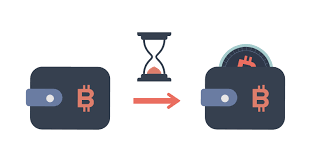Introduction
Making a Bitcoin transaction is usually straightforward. All you need is a Bitcoin wallet and the Bitcoin address of the person you’re sending to or receiving from. Once you make the transaction, Bitcoin miners add it to the Bitcoin blockchain, and it’s done.
But sometimes, Bitcoin transactions don’t go through right away. You might make a transaction, and it stays unconfirmed for a while. This means some Bitcoin has left your wallet, but it doesn’t show up anywhere else on the blockchain. This can make you worry that your money has disappeared. Don’t worry, though! Your funds aren’t lost. They’re just stuck in a waiting area called the mempool, waiting for miners to notice your transaction and add it to the next block of confirmed Bitcoin transactions.
In this guide, we’ll explain what happens to Bitcoin transactions that aren’t confirmed right away and how you can rebroadcast your Bitcoin transaction to get your funds moving again.
How Bitcoin Transactions Work
A Bitcoin transaction is different from other types of payments. When you use a credit card, you trust the bank to handle your money correctly. If there’s a problem, you can call the bank and ask them to fix it.
Bitcoin works differently. It uses a code and a network of computers spread all over the world. There’s no central authority you can call if you have a problem. Instead, your Bitcoin transactions are confirmed through a process called mining, which is done by the Bitcoin network.
When you make a Bitcoin transaction, you’re sending a message that says, “Address X is sending Y amount of Bitcoin to Address Z.” At first, this is an unconfirmed transaction. Your Bitcoin wallet adds the transaction to its memory pool (mempool) and sends the message to other computers on the network. Soon, all the computers can see your transaction.
Once your transaction is in the mempool, miners usually pick it up to add it to the blockchain. It usually takes about 10 minutes for a Bitcoin block to be mined, so your transaction could be confirmed within minutes. Once miners add your transaction to a block and validate it, the transaction is on the Bitcoin blockchain and is considered complete and unchangeable.
Why Might a Bitcoin Transaction Remain Unconfirmed?
Sometimes, your Bitcoin transaction might not be confirmed right away. Here are some reasons why:
- Network Traffic: Bitcoin has become very popular, which means there are often many transactions waiting to be confirmed. This can increase the waiting time for transaction confirmations.
- Block Size Limits: Bitcoin blocks have size limits, which means only a certain number of transactions can be added to each new block.
- Low Transaction Fees: Miners can choose which transactions to include in a block. They usually prefer transactions with higher fees because they get to keep these fees. If your transaction fee is too low, miners might not pick your transaction.
- Unusual Network Activity: Sometimes, there might be more activity on the Bitcoin network than usual. This can create a backlog of transactions waiting to be confirmed.
On a normal day, you can expect your Bitcoin transaction to be confirmed within a couple of hours. However, if there’s a lot of network activity, it might take longer for miners to pick up your transaction.
How to Check if Your Transaction is Stuck
Before you try to rebroadcast your transaction, it’s a good idea to check if it’s really stuck. Here’s how you can do that:
- Use a Block Explorer: Websites like Blockchain.com or BlockCypher allow you to check the status of your transaction. Just enter your transaction ID (TXID) in the search bar.
- Check the Mempool: Websites like mempool.space show you how many unconfirmed transactions are waiting. If there are many, it might explain why your transaction is taking longer.
- Wait a Bit Longer: Sometimes, transactions can take a day or more to confirm, especially if network traffic is high. If it hasn’t been too long, waiting might be the best option.
Methods to Rebroadcast or Accelerate Your Bitcoin Transaction
If your transaction has been stuck for a while, there are several methods you can use to try to speed it up. Let’s look at each of these methods in detail.
1. Replace by Fee (RBF)
Replace by Fee (RBF) is a feature in some Bitcoin wallets that allows you to increase the transaction fee of an unconfirmed transaction. Here’s how it works:
- You create a new transaction that’s identical to your original one, but with a higher fee.
- The original transaction is canceled, and the new one with the higher fee is more likely to be picked up by miners quickly.
Pros of RBF:
- It’s simple to use if your wallet supports it.
- You can often get your transaction confirmed quickly.
Cons of RBF:
- Not all wallets support this feature.
- You have to pay fees for both the original and the new transaction.
To use RBF, check if your wallet supports it. Popular wallets like Bitcoin Core and Electrum have this feature, but you might need to turn it on before making your original transaction.
2. Bitcoin Transaction Accelerators
Bitcoin transaction accelerators are services run by miners and mining pools. They allow you to submit your transaction directly to miners for inclusion in the next block. Here’s how to use them:
- Find a transaction accelerator service (some are free, others charge a fee).
- Submit your transaction ID (TXID) to the service.
- The mining pool will try to include your transaction in the next block they mine.
Pros of Transaction Accelerators:
- You don’t need to create a new transaction.
- Some services are free.
Cons of Transaction Accelerators:
- Free services often have limited slots and high demand.
- Paid services can be expensive.
- There’s no guarantee your transaction will be in the very next block.
Some popular transaction accelerators include ViaBTC (free but limited slots) and BTC.com (offers both free and paid options).
3. Child Pays for Parent (CPFP)
Child Pays for Parent is a method that can be used when you’re the one receiving an unconfirmed transaction. Here’s how it works:
- You create a new transaction (the “child”) that spends the Bitcoin from the unconfirmed transaction (the “parent”).
- You attach a high fee to the child transaction.
- Miners are incentivized to confirm both transactions together to collect the high fee.
Pros of CPFP:
- Useful when you’re the receiver of a stuck transaction.
- Can be effective even if the sender used a low fee.
Cons of CPFP:
- Requires some technical knowledge.
- Not all wallets support this feature.
To use CPFP, you need a wallet that supports this feature, such as Bitcoin Core or Electrum.
4. Double Spending (Not Recommended)
Double spending involves trying to send the same Bitcoin twice. While it’s possible, it’s not recommended because:
- It goes against the fundamental principles of Bitcoin.
- It’s technically difficult to do with regular wallet software.
- There’s a high risk that both transactions will be ignored or canceled.
Due to these risks, we don’t recommend using this method. It’s included here for completeness, but the other methods are safer and more reliable.
Best Practices to Avoid Stuck Transactions
Prevention is better than cure. Here are some tips to help you avoid stuck transactions in the future:
- Use a Wallet with RBF: Choose a wallet that supports Replace by Fee. This gives you more options if your transaction gets stuck.
- Check Network Congestion: Before sending a transaction, check the current state of the Bitcoin network. If it’s congested, consider waiting or using a higher fee.
- Use Appropriate Fees: Use a fee estimation tool to choose an appropriate fee for your transaction. Higher priority transactions should use higher fees.
- Don’t Rush Non-Urgent Transactions: If your transaction isn’t urgent, use a lower fee and be patient. It might take longer, but it will likely go through eventually.
- Understand Your Wallet’s Features: Know whether your wallet supports RBF or CPFP. This knowledge can be very helpful if a transaction gets stuck.
What Happens if You Do Nothing?
If you decide not to take any action, here’s what usually happens:
- The transaction might eventually be confirmed if network congestion decreases.
- Most nodes automatically delete unconfirmed transactions from their mempool after 72 hours. If this happens, the Bitcoin will return to your wallet.
- In rare cases, a node might keep broadcasting the transaction after 72 hours. If you suspect this is happening, you might need to use one of the methods described above.
Conclusion
While stuck Bitcoin transactions can be frustrating, they’re usually not a cause for panic. In most cases, your transaction will either go through eventually or the Bitcoin will return to your wallet.
If you need to speed up a transaction, Replace by Fee is often the simplest method if your wallet supports it. Transaction accelerators can also be effective, especially if you’re willing to pay for a premium service. For receivers, Child Pays for Parent can be a useful technique.
Remember, the Bitcoin network can sometimes be slow, especially during times of high activity. Planning ahead, using appropriate fees, and being patient can help you avoid many issues with stuck transactions.
As you become more familiar with how Bitcoin works, you’ll get better at predicting when transactions might take longer and how to avoid delays. With this knowledge, you’ll be well-equipped to handle any transaction issues that come your way in your Bitcoin journey.


